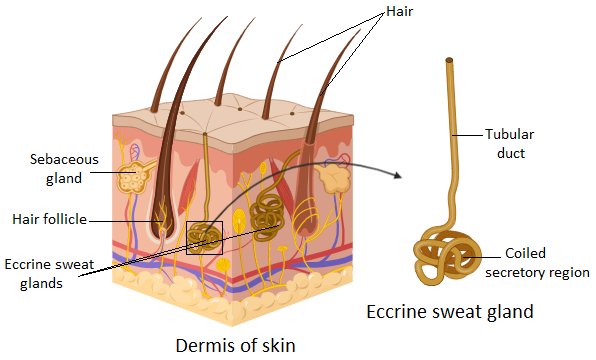
Simple coiled tubular glands are found in
A. Dermis of skin
B. Kidney
C. Liver
D. Spleen
Answer
556.2k+ views
Hint:Glands are secretory structures that produce various important biological secretions. The coiled tubular glands are made of a very long and unbranched duct. This duct continues with the coiled portion which is the secretory portion. An example of this is the eccrine sweat gland.
Complete answer:Glands are structures of cells that synthesize and secrete substances such as hormones, oils, sweat, etc. either inside the body or on its outer surface. There are two major types of glands. These are called exocrine glands and endocrine glands. The endocrine gland products circulate along with the bloodstream whereas exocrine gland products are secreted through a duct. The secretion of exocrine glands passes through ducts that terminate either externally to the skin or internally to organs.

Simple coiled tubular glands have a very long duct which is a cylindrical structure. The duct terminates outside the skin surface and thus it is an exocrine gland. The base of the coiled tubular gland is coiled and it is the main secretory region. These glands are usually unbranched. An example of these glands is the eccrine gland. It is the major sweat gland that lies in the dermis layer of the skin. All of the skin consists of these glands. Palm, head, and sole regions contain these glands in high density. Their secretion is a clear odorless substance called sweat. It primarily consists of water. The secretions are excreted through sweat pores on the skin.
Therefore, from the above discussion, we can conclude that the right answer is option A.
Note: The coiled portion of the simple coiled tubular glands is made of two concentric layers of columnar or cuboidal epithelial cells. Myoepithelial cells interpose the underlying epithelial cells. Above the myoepithelial cells lie the secretory epithelial cells.
Complete answer:Glands are structures of cells that synthesize and secrete substances such as hormones, oils, sweat, etc. either inside the body or on its outer surface. There are two major types of glands. These are called exocrine glands and endocrine glands. The endocrine gland products circulate along with the bloodstream whereas exocrine gland products are secreted through a duct. The secretion of exocrine glands passes through ducts that terminate either externally to the skin or internally to organs.

Simple coiled tubular glands have a very long duct which is a cylindrical structure. The duct terminates outside the skin surface and thus it is an exocrine gland. The base of the coiled tubular gland is coiled and it is the main secretory region. These glands are usually unbranched. An example of these glands is the eccrine gland. It is the major sweat gland that lies in the dermis layer of the skin. All of the skin consists of these glands. Palm, head, and sole regions contain these glands in high density. Their secretion is a clear odorless substance called sweat. It primarily consists of water. The secretions are excreted through sweat pores on the skin.
Therefore, from the above discussion, we can conclude that the right answer is option A.
Note: The coiled portion of the simple coiled tubular glands is made of two concentric layers of columnar or cuboidal epithelial cells. Myoepithelial cells interpose the underlying epithelial cells. Above the myoepithelial cells lie the secretory epithelial cells.
Recently Updated Pages
Master Class 11 Business Studies: Engaging Questions & Answers for Success

Master Class 11 English: Engaging Questions & Answers for Success

Master Class 11 Computer Science: Engaging Questions & Answers for Success

Master Class 11 Social Science: Engaging Questions & Answers for Success

Master Class 11 Maths: Engaging Questions & Answers for Success

Master Class 11 Biology: Engaging Questions & Answers for Success

Trending doubts
One Metric ton is equal to kg A 10000 B 1000 C 100 class 11 physics CBSE

Explain zero factorial class 11 maths CBSE

An example of chemosynthetic bacteria is A E coli B class 11 biology CBSE

State the laws of reflection of light

Name the metals and nonmetals in the first twenty class 11 chemistry CBSE

What is 1s 2s 2p 3s 3p class 11 chemistry CBSE




